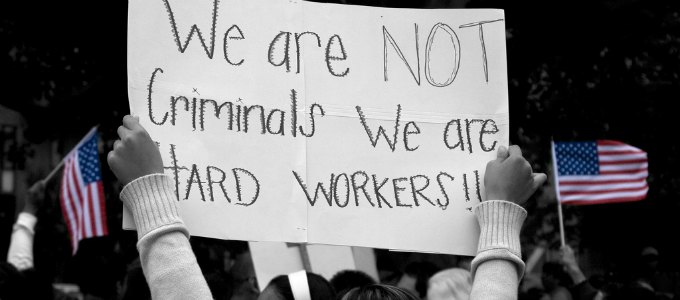
Immigration lawyer Rebecca Bernhard discusses why current immigration laws make it difficult for U.S. companies to recruit global talent.
by Amy Whyte
July 13, 2015
Immigration has been a topic without resolution, as seen from this San Diego march in 2007. (Photo by Michael Righi, courtesy of Flickr)
As an employment-based immigration lawyer, Rebecca Bernhard works closely with immigrants and employers to navigate the often difficult path of hiring from abroad.
Bernhard, a labor and employment attorney at international firm Dorsey & Whitney, said current U.S. immigration laws can prevent companies from fully accessing the global workforce — and therefore, the best possible talent.
Bernhard spoke with Diversity Executive about the difficulties faced by immigrant employees, and why recruiting global talent is so important. Below are edited excerpts from her interview.
What are some of the biggest challenges immigrant employees face?
For those immigrants who are seeking employment-based work authorization, some of the biggest challenges in the current system include the numerical caps for certain types of professionals and the backlogs for green cards for certain nationalities. As has been highly publicized, the H-1B nonimmigrant visa, which provides for employment for foreign nationals in certain professional and specialty occupations, has an annual limit of 65,000 visas. There are an additional 20,000 reserved for people with advanced degrees from a U.S. institution. This year, more than 233,000 people applied for those 85,000 slots.
What is even more troubling is that the U.S. is educating over one million foreign students and, according to the various reports from agencies like ICE [Immigration and Customs Enforcement], the percent of these students graduating with degrees is science, technology, engineering or math [STEM degrees] is historically around 35 percent. Even if all 65,000 H-1B visas went to these STEM graduates, we would still be exporting a sizable majority of our locally educated talent.

And if the immigrant employee is lucky enough to win the H-1B lottery, after six years she may need to go home if she cannot secure her green card. Generally, U.S. Citizens and Immigration Services (USCIS) limits any one country’s share of green cards to less than 10 percent of the total, and this rule contributes to a huge backlog for Indian and Chinese nationals, the two largest foreign-student populations.
How can companies better support immigrant employees through the relocation process?
In my practice, which is limited to employment-based immigration, the employer-clients who most successfully support their immigrant employees are those that understand the special circumstances these employees are working and living under. Such employers pay the full cost of filing and legal fees associated with petitioning USCIS for nonimmigrant and employment-based visa status. But their support goes beyond that. Supportive employers also tend to understand the delays employees face, the unpredictability in requests for additional information and the emotional rollercoasters their immigrant employees are on and provide for flexibility throughout the process in terms of arrival dates, the need to attend interviews and the help in gathering necessary documentation.
Why is it important for companies to be able to bring in employees from other countries?
In order to compete in today’s knowledge-based, global economy, we need to be able to attract and retain the best talent. That talent is no longer primarily locally-based. Less and less U.S. students are pursuing STEM degrees, yet the need for such skills continues to grow. Further, as companies within the U.S. strive to compete, maintaining a diverse workforce in the U.S. that successfully interacts with employees working abroad helps provide for greater opportunities to serve clients and customers throughout the world.
For several years now, economic policy institutes have been publicizing their research that emphasizes the economic benefits of expanded immigration to the growth of the U.S. economy. The general consensus among such policy institutes is that immigrants and U.S. workers complement each other, rather than compete with each other for limited job opportunities. For example, the Manhattan Research Policy Institute and the Brookings Institute both have publicized research showing that immigrants help reduce labor shortages in both in the high- and low-skill areas and in turn, more workers overall create a demand for expanded economic opportunities. In this vein, enhancing the mobility of the global labor force will enhance the U.S. economy.



